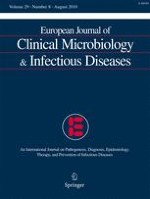Published in:

01-08-2010 | Article
Clinical and laboratory features of invasive community-onset methicillin-resistant Staphylococcus aureus infection: a prospective case–control study
Authors:
M. C. Wehrhahn, J. O. Robinson, J. C. Pearson, F. G. O’Brien, H. L. Tan, G. W. Coombs, E. M. Pascoe, R. Lee, P. Salvaris, R. Salvaris, D. New, R. J. Murray
Published in:
European Journal of Clinical Microbiology & Infectious Diseases
|
Issue 8/2010
Login to get access
Abstract
Differences between the features of invasive community-onset methicillin-resistant Staphylococcus aureus (cMRSA) and methicillin-susceptible S. aureus (cMSSA) infections are incompletely understood. Fifty-seven patients with invasive cMRSA infection were prospectively identified at two teaching hospitals; for each cMRSA case, two cases of invasive cMSSA infection acted as controls. The primary outcome was 30-day all-cause mortality. Patients with invasive cMRSA infection were more likely to be Aboriginal (25% vs. 14%, age-adjusted odds ratio [OR] 2.5, p = 0.037), reside in a long-term care facility and/or have been hospitalised in the previous year (51% vs. 34%, p = 0.04) and less likely to have endocarditis (2% vs. 12%, p = 0.02) or require admission to an intensive care unit or high-dependency area (7% vs. 21%, p = 0.02). All-cause mortality at 30 days was similar in the cMRSA and cMSSA groups (9% vs. 7%, p = 0.68). Panton–Valentine leukocidin (PVL) genes were detected in a similar proportion of cMRSA and cMSSA isolates (32% vs. 27%, p = 0.49) and the presence of PVL genes was associated with younger age (35 years vs. 55 years, p < 0.001), Aboriginal ethnicity (38% vs. 10%, p < 0.001), skin and soft-tissue infection (54% vs. 19%, p < 0.001), lower illness severity at presentation (SAPS II score 9 vs. 21, p = 0.001) and shorter hospitalisation (9 days vs. 24 days, p < 0.001). Patients with “PVL-positive” and “PVL-negative” S. aureus infection had similar 30-day all-cause mortality (4% vs. 9%, p = 0.28). Few clinical features differentiated patients with invasive cMRSA infection from those with infection caused by cMSSA. Invasive “PVL-positive” S. aureus infection was associated with less morbidity but similar mortality to “PVL-negative” infection.





